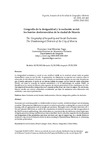Please use this identifier to cite or link to this item:
https://accedacris.ulpgc.es/handle/10553/70275
| DC Field | Value | Language |
|---|---|---|
| dc.contributor.author | Morales Yago, Francisco José | en_US |
| dc.date.accessioned | 2020-02-13T12:50:05Z | - |
| dc.date.available | 2020-02-13T12:50:05Z | - |
| dc.date.issued | 2020 | en_US |
| dc.identifier.issn | 1133-598X | en_US |
| dc.identifier.uri | https://accedacris.ulpgc.es/handle/10553/70275 | - |
| dc.description.abstract | La desigualdad económica y social es una realidad visible en la sociedad actual, tanto en países desarrollados como en vías de ello. Es generadora de diferencias en aspectos tan variados como la educación, la vida laboral o el acceso a una vivienda en condiciones dignas con una ratio de personas por vivienda adecuada. A través de un intenso trabajo de campo con un total de veinte entrevistas (N=20), así como la consulta de fuentes estadísticas y de la metodología de análisis DAFO, se identifican en la ciudad de Murcia ocho espacios de mayor precariedad en las condiciones de vida. Esto impide el desarrollo e integración en el conjunto poblacional, sin visos de mejora. De esta forma, Murcia, resulta una ciudad contrastada socialmente, que lejos de minimizar estas diferencias está asistiendo a una mayor polarización. | en_US |
| dc.description.abstract | Economic and social inequality is a visible reality in today’s society, in both developed and developing countries. This generates differences in aspects as varied as education, working life or access to decent housing with an appropriate ratio of people per residence. Through a total of twenty interviews (N = 20) and intensive fieldwork, as well as the consultation of statistical sources and the incorporation of the SWOT analysis methodology, this article offers as a case study the city of Murcia, where eight areas of highly precarious living conditions have been identified. Such a situation impedes the development and integration of the population, and does not show any sign of improving. As a result, Murcia is rendered a city of social contrasts which, far from working to diminish these differences, is witnessing yet further polarization. | en_US |
| dc.language | spa | en_US |
| dc.relation.ispartof | Vegueta: Anuario de la Facultad de Geografía e Historia | en_US |
| dc.source | Vegueta: Anuario de la Facultad de Geografía e Historia [eISSN: 2341-1112], n. 20, p. 433-468 | en_US |
| dc.subject | 55 Historia | en_US |
| dc.subject.other | Exclusión social | en_US |
| dc.subject.other | Barrios desfavorecidos | en_US |
| dc.subject.other | Murcia | en_US |
| dc.subject.other | Integración | en_US |
| dc.subject.other | Política de ciudades | en_US |
| dc.subject.other | Social Exclusion | en_US |
| dc.subject.other | Disadvantaged Areas | en_US |
| dc.subject.other | Integration | en_US |
| dc.subject.other | Urban Policy | en_US |
| dc.title | Geografía de la desigualdad y la exclusión social: los barrios desfavorecidos de la ciudad de Murcia | en_US |
| dc.title.alternative | The Geography of Inequality and Social Exclusion: The Disadvantaged Districts of the City of Murcia | en_US |
| dc.type | info:eu-repo/semantics/article | en_US |
| dc.type | Article | en_US |
| dc.investigacion | Artes y Humanidades | en_US |
| dc.type2 | Artículo | en_US |
| dc.identifier.ulpgc | Sí | es |
| dc.description.esci | ESCI | |
| dc.description.fecytq | Q2 | |
| dc.description.fecytpuntuacion | 27,21 | |
| dc.description.dialnetimpact | 0,0 | |
| dc.description.dialnetq | Q1 | |
| dc.description.dialnetd | D2 | |
| dc.description.erihplus | ERIH PLUS | |
| item.fulltext | Con texto completo | - |
| item.grantfulltext | open | - |
| Appears in Collections: | Artículos | |
Page view(s)
222
checked on Feb 24, 2024
Download(s)
272
checked on Feb 24, 2024
Google ScholarTM
Check
Share
Export metadata
Items in accedaCRIS are protected by copyright, with all rights reserved, unless otherwise indicated.
